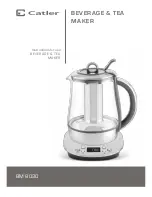
13
Guidelines for Vacuum Packaging continued
Vacuum Packaging Coffee and Powdery Foods:
To prevent food particles from being drawn
into vacuum pump, place a coffee filter or
paper towel inside the bag, above the coffee
and below the top of the bag, before vacuum
packaging.
You can also place the food in its original bag
inside a FoodSaver
®
Bag.
Vacuum Packaging Liquids:
Using a FoodSaver
®
Container is the easiest
way to vacuum seal liquids. Pouring liquids
into a FoodSaver
®
bag then using Seal only is
a quick way to prepare liquids for storage.
Alternatively pre-freeze liquids until solid,
remove from freezer and vacuum package in
a FoodSaver
®
bag. Then return to the freezer.
When you’re ready to use, just cut corner of
bag and place in a dish in microwave or drop
into water at a low simmer, below 75°C.
Vacuum Packaging Snack Foods:
Your snack foods will maintain their freshness
longer when you vacuum package them.
For best results, use a FoodSaver
®
Container
for crushable items like crackers.
Vacuum Packaging Non-Food Items
The FoodSaver
®
vacuum packaging system
also protects non-food items from oxidation,
corrosion and moisture. Simply follow the
directions to vacuum package items using
FoodSaver
®
Bags & Containers.
To vacuum package silver, wrap
forks in soft cushioning material,
such as a paper towel,
to avoid puncturing bag.
Your FoodSaver
®
Bags are ideal for
outdoor excursions. For camping
and hiking, keep your matches,
maps and food dry and compact.
To have fresh water for drinking,
simply fill a FoodSaver
®
Bag with
ice, seal it and when needed, let
the ice pack melt.
If you’re going sailing or boating,
vacuum package your food, film
and a dry change of clothes. Just
remember to bring scissors or a
knife to open the bag.
To keep emergency kits safe
and dry, vacuum package flares,
batteries, flashlights, matches,
candles and other necessities.
Your emergency items will stay dry
and organized in your home, car or
boat.
Natural Gases in Foods
The release of natural gases or fermentation
from foods, (such as fresh fruits and
vegetables) can add air back into a vacuum
packaged bag. To prevent this occurring,
vegetables can be blanched prior to vacuum
packing. See page 13 for more details.
Pre-freezing meats prior to vacuum packaging
can prevent natural gases being released.
Summary of Contents for FoodSaver Lock & Seal VS4500
Page 1: ...Home Vacuum Packaging System Lock Seal User Guide VS4500...
Page 20: ...Notes 18...
Page 21: ...Notes 19...
Page 22: ...20 Notes...










































